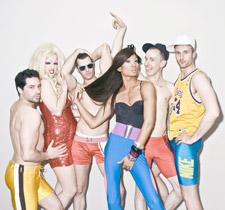A year-and-a-half ago the long-vacant space that used to house Babylon (once one of Church St’s favourite martini bars) was reincarnated as Straight. Without a doubt the new moniker had homos abuzz.
Renda Abdo, already well known for her popular-with-the-gay-crowd hangouts 7 West and Black Skirt (formally Wish), had been mulling over whether or not she was up for taking on yet another business venture. “It’s a tough game, the bar business,” she says, “I kept saying to myself, ‘I’m getting old, I don’t want to do the club thing again.’ But this was so important to me. It wasn’t about how much money it could make, it was more about giving something back to the community, giving them a place to go.”
At the time she was spurred on by an article in the Toronto Star called “Goodbye Gaytown?” Abdo refused to accept its premise that the community was fading away. “That article was very upsetting for me. Fine. If you are saying to me that our village is gone then it’s really that simple. I opened a bar and called it Straight. And it was just a name, we weren’t labelling it or anything.” Straight became a statement, one that could have gone either way: It could have lived up to its name and become the first straight bar on the strip or, like Abdo hoped, it would create a stir.
“Everyone else in the city was going through a real renaissance at the time,” says Straight’s entertainment coordinator Shanker Bhardwaj, “so Renda wanted to bring something special back to Church St.”
And it worked. Intrigued gay boys and girls alike were drawn to the space and before long two of the community’s premiere party hostesses — Charles Pavia and Gairy Brown — had adopted the space as their new “it” place to be.
“The boys just came in and took it over and wanted to dance,” says Bhardwaj with a laugh. Straight has been going strong at least two nights a week ever since since. Suddenly Church St had a new destination nightspot, but this time it wasn’t about drugs and dancing, it was more about being social with each other and hanging out.
“There’s a real freedom to just talk to anyone and boys can meet other boys,” says Bhardwaj. “We always say, ‘Straight, it’s a sure thing.’ Everybody always ends up meeting someone there.”
Abdo agrees. “When you’ve got very limited numbers [Straight’s capacity is 200] you can’t help but have an intimate space. You’re going to be bumping and rubbing up against everyone, so that really adds to the whole experience.
“I didn’t know it would do this well,” says Abdo, “but I think it just indicates how much our community needs spaces like this. When I walk in there I’m always thinking, ‘My God, everyone is so beautiful!’ And I don’t see that when I go out other places. The night and the people that go are always so well put together. It feels so good.”
There is an interesting contrast in hearing Abdo and Bhardwaj speak about the community. Bhardwaj seems used to having a gay village around like it’s a favourite pair of shoes he wouldn’t know what to do without; whereas Abdo was around when it was still establishing itself after the bathhouse raids and the onset of AIDS. To them both, though, it’s vital to give something back.
“When I was 15 or 16 I loved being on Church St, knowing that I could be myself comfortably — that was so important,” says Abdo. “It’s great that the market will shift and the clubs along King St or Queen will do a gay night and throw a party for us. But every major city needs a gay village. You need somewhere you feel completely yourself.”
“It’s really a bar for the community populated by those of us who love to make our own culture happen. I think if an out-of-towner came to Straight they’d see a very good representation of what we’re all about,” says Bhardwaj.
“There is longevity in the community, especially if you keep giving something back to it,” Abdo says. “I guess I just wanted to leave my little rainbow mark somewhere.”

 Why you can trust Xtra
Why you can trust Xtra


